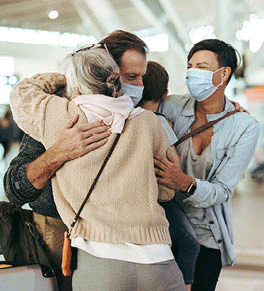Traveling safely for the holidays

Travel has been an ever-changing landscape since the start of the pandemic and this year’s winter holidays is no different.
“Yes, it is possible for friends and families to visit during the holidays,” says Dr. Susan Huang, medical director of epidemiology and infection prevention for UCI Health. “But it will take some serious advance planning to keep everyone safe from COVID-19, especially with the recent arrival of the omicron variant.”
“Whether or not you travel should be predicated by your vaccination status and careful assessment of the risks to you and your family,” she advises.
Get your booster shot
The highly contagious omicron variant has changed the travel game once again. The makers of the Pfizer-BioNTech vaccine have already determined that three doses of its vaccine are needed to neutralize it.
For Huang, this means everyone who is eligible needs a COVID-19 booster. “Booster shots are essential for protecting ourselves, those children under age 5 who are not eligible for a vaccine and those whose immune system can’t mount a full response to the vaccine.”
Booster shots enable the body’s immune system to fight breakthrough infections of COVID-19 and can help prevent severe cases and hospitalization. They are now widely available for all vaccinated adolescents and adults, age 16 and older.
“I encourage everyone who is eligible to get theirs at least two weeks before visiting grandparents or other high-risk family members so it can take full effect,” says Huang.
Get vaccinated
Because travel poses a greater risk for the unvaccinated, the Centers for Disease Control and Prevention (CDC) urges all who are eligible to get inoculated before traveling or stay home.
If you are unvaccinated or not fully vaccinated and you must travel within the United States, the CDC recommends getting a COVID-19 viral test one to three days before your trip — and to travel only if it’s negative or you have completed quarantine from a prior infection.
After arriving at your destination, the CDC recommends a second test. Some destinations may also require that you quarantine for a certain time, even if your first test was negative.
As of Dec. 6, all international air travelers — regardless of vaccination status or citizenship — must get a COVID-19 viral test no more than one day before a U.S.-bound flight. You must show proof of a negative result in order to board your plane.
Travel precautions
If you’re planning to travel during the holiday season, it’s imperative to do so as safely as possible and to plan ahead.
Masks that cover the nose and mouth are now required on planes, buses, trains and other forms of public transportation traveling within, to or from the United States. They are also mandatory inside U.S. airports, train stations and other transit terminals.
“Everyone, even people who are fully vaccinated, is required to wear a mask on public transportation,” the CDC says.
Before travel, the CDC recommends:
- Checking the latest COVID-19 situation at your destination
- Following all state, local and territorial travel guidelines at your destination
- Checking with your travel carrier for testing, vaccination and other requirements
- Being flexible because restrictions and policies may change while you’re traveling
Travel safety tips
Besides masking in public places, especially when indoors, other measures have been proven to reduce viral transmission.“You should also follow the other safety protocols,” says Huang. “These include washing your hands or using hand sanitizer frequently and distancing as much as possible from people who aren’t part of your household.”
Consider these scenarios to better understand what’s needed for safety:
- Eat before boarding: The riskiest time for exposure is when you have your mask off. So, instead of buying something to eat on the airplane, arrive a little early and take your purchased food to a less-crowded area within the airport and eat before getting aboard.
- Mask hygiene: Use hand sanitizer that contains at least 60% alcohol before removing your mask, place it in a clean bag for safekeeping, use hand sanitizer before and after you eat or drink, and also before putting on your mask again.
- Clean your seating area: Use a disinfectant wipe (provided by the carrier or carry your own) to clean your seating area, including the seat belt buckle, armrests, tray table, entertainment screen and remote.
- Bathroom safety: Wash your hands well after using a lavatory.
- Passing items: Use hand sanitizer before and after passing items back and forth between crew members and other passengers.
Research your destination
The greater the number of cases at your destination, the more likely you are to get infected during travel and potentially spread the virus to others when you return.
The CDC’s travel page is a great resource for the latest health information and guidance. It’s also wise to also check the guidance offered by the health department in the area you’re visiting. COVID-19 precautions and mandates change quickly and vary by state, county and city.
More and more cities and states are once again mandating indoor masking in public places. So far, this includes California, Connecticut, Hawaii, Illinois, New Mexico, New York, Nevada, Oregon, Washington and the District of Columbia.
Resources to consult before you buy those tickets:
- Each state’s cases in the last seven days
- Travel recommendations for destinations around the world
- State, local and territorial government websites
If COVID-19 cases are surging in an area you plan to visit, Huang recommends delaying travel.
Related stories
Explore further
Browse more blog posts by topic.




